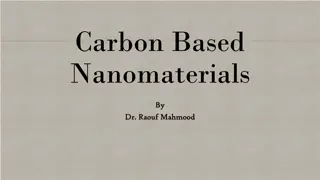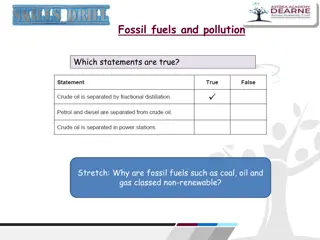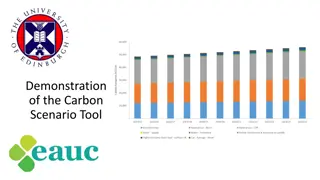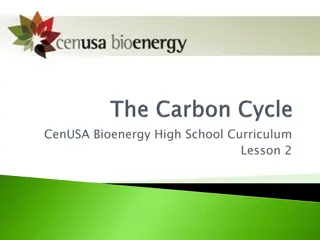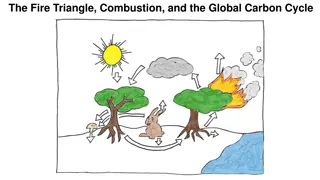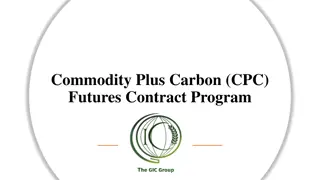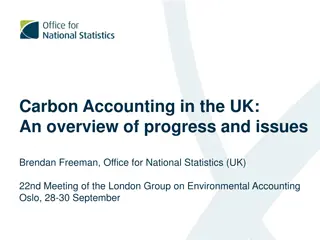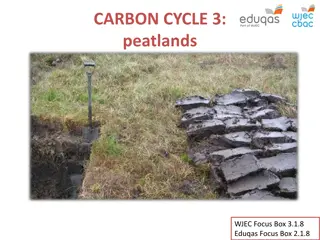Understanding the Carbon Cycle and Its Impact
Explore the intricacies of the carbon cycle, the fundamental building block of life, and the five spheres of Earth involved in this crucial process. Learn about carbon sources and sinks, its role in chemical processes, and its significance in the Earth's energy balance. Discover key points about the carbon cycle and its impact on the environment. Engage in an in-class activity to deepen your understanding.
Download Presentation

Please find below an Image/Link to download the presentation.
The content on the website is provided AS IS for your information and personal use only. It may not be sold, licensed, or shared on other websites without obtaining consent from the author. Download presentation by click this link. If you encounter any issues during the download, it is possible that the publisher has removed the file from their server.
E N D
Presentation Transcript
Educator Instructions REMOVE THIS SLIDE BEFORE PRESENTING Customize this presentation to fit your needs. Please add or remove content.
CARBON CYCLE Source: http://www.dec.ny.gov/energy/76572.html
THE EARTH HAS FIVE SPHERES THAT ARE PART OF THE CARBON CYCLE: ATMOSPHERE Envelope of gases surrounding earth LITHOSPHERE Rigid outer part of earth s surface 1 4 BIOSPHERE Regions of earth s surface occupied by living organisms HYDROSPHERE All bodies of water 2 5 CRYOSPHERE Frozen part of earth s surface 3
CARBON IS THE FUNDAMENTAL BUILDING BLOCK OF LIFE All living organisms are built of carbon compounds. It is the fundamental building block of life and an important component of many chemical processes. In the atmosphere, carbon is present primarily as carbon dioxide (CO2), but also as other less abundant but climatically significant gases, such as methane (CH4).
WHAT'S THE DEAL WITH CARBON? This animation describes the carbon cycle and how it is affected by human activity. It was featured in the Sustainable Shelters exhibit at the Bell Museum of Natural History at the University of Minnesota.
KEY POINTS TO KNOW ABOUT THE CARBON CYCLE o Life is fueled by carbon compounds o Carbon sink: more carbon enters a pool than leaves it o CO2 is released by the burning of fossil fuels o Carbon source: more carbon leaves a pool than enters o The atmosphere and oceans are continuously exchanging CO2 o The carbon cycle consists of reservoirs that store carbon (the atmosphere, the oceans, vegetation, rocks, and soil) and processes by which carbon moves between these reservoirs o Carbon dioxide is a major player in the Earth s energy balance
IN-CLASS ACTIVITY POGIL Activity: The Carbon Cycle (Download PDF) About POGIL Activities: You can learn more about POGIL at: https://pogil.org/about What is POGIL? from The POGIL Project on Vimeo.
MORE INFORMATION AND RESOURCES The Department of Geosciences at Georgia State University has published a set of labs that may be helpful. Of particular interest are the following: Lab 4 The Carbon Cycle (Part 1) http://sites.gsu.edu/geog1112/lab-4-2/ Lab 4 The Carbon Cycle (Part 2) http://sites.gsu.edu/geog1112/lab-4-the- carbon-cycle-part-2/ TED Talk The Carbon Cycle (3:54 minutes) http://ed.ted.com/lessons/the-carbon-cycle-nathaniel- manning by Nathaniel Manning and Jill Johnston






